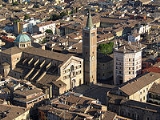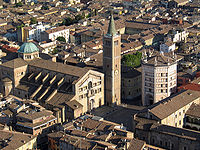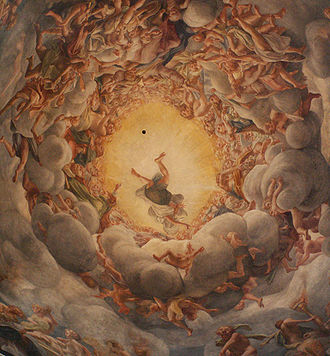
Cathedral of Parma
Encyclopedia


Cathedral
A cathedral is a Christian church that contains the seat of a bishop...
church in Parma
Parma
Parma is a city in the Italian region of Emilia-Romagna famous for its ham, its cheese, its architecture and the fine countryside around it. This is the home of the University of Parma, one of the oldest universities in the world....
, Emilia-Romagna
Emilia-Romagna
Emilia–Romagna is an administrative region of Northern Italy comprising the two historic regions of Emilia and Romagna. The capital is Bologna; it has an area of and about 4.4 million inhabitants....
(Italy
Italy
Italy , officially the Italian Republic languages]] under the European Charter for Regional or Minority Languages. In each of these, Italy's official name is as follows:;;;;;;;;), is a unitary parliamentary republic in South-Central Europe. To the north it borders France, Switzerland, Austria and...
). It is an important Italian Romanesque
Romanesque architecture
Romanesque architecture is an architectural style of Medieval Europe characterised by semi-circular arches. There is no consensus for the beginning date of the Romanesque architecture, with proposals ranging from the 6th to the 10th century. It developed in the 12th century into the Gothic style,...
cathedral: the dome, in particular, is decorated by a highly influential illusionistic fresco by Renaissance painter Antonio da Correggio
Antonio da Correggio
Antonio Allegri da Correggio , usually known as Correggio, was the foremost painter of the Parma school of the Italian Renaissance, who was responsible for some of the most vigorous and sensuous works of the 16th century...
.
History
The construction was begun in 1059 by bishop Cadalo, later antipope with the name of Honorius IIAntipope Honorius II
Honorius II , born Pietro Cadalus, was an antipope from 1061 to 1072. He was born at Verona and became bishop of Parma in 1046. He died at Parma in 1072....
, and was consecrated by Paschal II in 1116. A basilica existed probably in the 6th century, but was later abandoned; another church had been consecrated in the rear part of the preceding one in the 9th century by the count-bishop Guibodo. The new church was heavily damaged by an earthquake in 1117 and had to be restored. Of the original building, remains can be seen in the presbytery, the transept, the choir and the apses, and in some sculpture fragments. The wide façade was completed in 1178: it has three loggia
Loggia
Loggia is the name given to an architectural feature, originally of Minoan design. They are often a gallery or corridor at ground level, sometimes higher, on the facade of a building and open to the air on one side, where it is supported by columns or pierced openings in the wall...
floors and three portals, whose doors were sculpted by Luchino Bianchino in 1494. Between the central and the right doors is the tomb of the mathematician Biagio Pelacani, who died in 1416.
The Gothic belfry was added later, in 1284-1294: a twin construction on the left side had been conceived, but it was never begun. Beside the Cathedral lies the octagonal Baptistry of Parma.
Interior
The interior has a Latin cross plan, with a nave and two aisles divided by pilasters. The presbytery and the transept are elevated, to allow space for the underlying crypt. The latter houses fragments of ancient mosaics which show the presence here of a cult temple from at least in the 3rd or 4th century AD. The side chapels were built to house the sepulchers of the noble families of Parma: two of them, the Valeri Chapel and the Commune Chapel, have maintained the original decoration from the 14th century.Particularly noteworthy are the capitals, also in the exterior: many of them are characterized by rich decorations with leaves, mythological figures, scenes of war, as well as Biblical and Gospel scenes. The paintings, as revealed by a capital stripped of the 16th century gold painting, were originally polychrome.
In the right transept is the Deposition by Benedetto Antelami
Benedetto Antelami
Benedetto Antelami was an Italian architect and sculptor of the Romanesque school, whose "sculptural style sprang from local north Italian traditions that can be traced back to late antiquity" Little is known about his life. He was probably originally from Lombardy, perhaps born in Val d'Intelvi...
(1178). The cycle of frescoes in the nave and apse walls are by Lattanzio Gambara
Lattanzio Gambara
Lattanzio Gambara was an Italian painter, active in a Renaissance and Mannerist styles.-Biography:Born in Brescia, as a 15 year old he initially apprenticed with Giulio Campi in Cremona, by 1549, he is working alongside Girolamo Romanino, who became his father-in-law. An altarpiece of S. Maria in...
and Bernardino Gatti
Bernardino Gatti
Bernardino Gatti was an Italian painter of the Renaissance, active mainly in Parma and Cremona.Born in or near Pavia or Cremona. He is also commonly called il Sojaro. His early apprenticeship is unclear, though he is influenced by the pre-eminent local painters: Pordenone, alongside whose works...
. Along the nave, in the lunnetes above the spans are monochrome frescoes of Old Testament stories, as well as event of the passion. This culminates in the apse cupola, frescoed with ‘’Christ, Mary, Saints, and Angels in Glory’’ (1538-1544) by Girolamo Mazzola Bedoli
Girolamo Mazzola Bedoli
Girolamo Mazzola Bedoli was an Italian painter of the Parmesan school of Painting, active in the Mannerist style.Bedoli was born in Parma in a family coming from Viadana...
. The 15th century frescoes in the Valeri Chapel are attributed to the studio of Bertolino de'Grossi. Those in the Capella del Comune, presumably by the same hands, were painted after the plague of 1410-11, and dedicated to Saint Sebastian. The Crypt has a monument to Saint Bernardo di Uberti, bishop of Parma 1106-1133, patron of the diocese. The monument, executed in the 1544 by Prospero and Girolamo Clementi on design of Bèdoli Mazzola.
The sacristy contains works attributed to Luchino Bianchini (1491). There are four reliefs by Benedetto Antelami, from 1178. The portal also has two carvings by Luchino Bianchino. Two great marble lions support the archivolt columns, and were carved in the 1281 by Giambono da Bissone. The Ravacaldi chapel has frescoes attriguted to the studio of Bertolino de’Grassi.
The main feature of the interior is the fresco of Assumption of the Virgin
Assumption of the Virgin (Correggio)
The Assumption of the Virgin is a fresco by the Italian Late Renaissance artist Antonio da Correggio decorating the dome of the Cathedral of Parma, Italy. Correggio signed the contract for the painting on November 3, 1522...
decorating the dome, executed by Correggio
Antonio da Correggio
Antonio Allegri da Correggio , usually known as Correggio, was the foremost painter of the Parma school of the Italian Renaissance, who was responsible for some of the most vigorous and sensuous works of the 16th century...
in 1526-1530.

